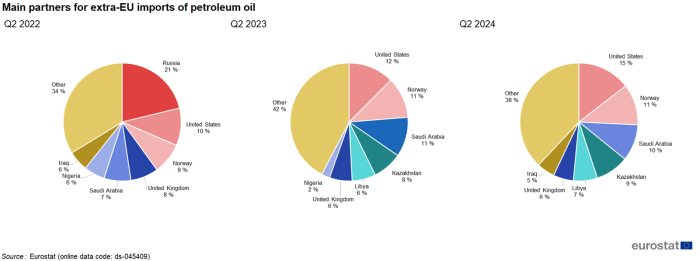EU trade with Russia - latest developments
Data extracted in August 2024
Planned article update: 25 November 2024
Highlights
This article provides a picture of the international trade of main product groups exchanged between the European Union (EU) and Russia. More general information on trade with Russia is available in ![]() this excel file. This article is part of an online publication providing recent statistics on international trade in goods, covering information on the EU's main partners, main goods traded, specific characteristics of trade as well as background information.
this excel file. This article is part of an online publication providing recent statistics on international trade in goods, covering information on the EU's main partners, main goods traded, specific characteristics of trade as well as background information.
Full article
Latest developments
EU trade with Russia has been strongly affected since the start of Russia's invasion of Ukraine. The EU has imposed various import and export restrictions on several products, resulting in a 59% decline in exports to Russia and an 87% drop in imports from Russia between the second quarter of 2022 and the second quarter of 2024 (see Figure 1). In particular, in the second quarter of 2024, both imports from and exports to Russia decreased by 16.0% and 9.5%, respectively, compared with the previous quarter. As a result, the EU's trade deficit with Russia stood at €0.2 billion, significantly below the deficit peak of €45.8 billion recorded in the second quarter of 2022.
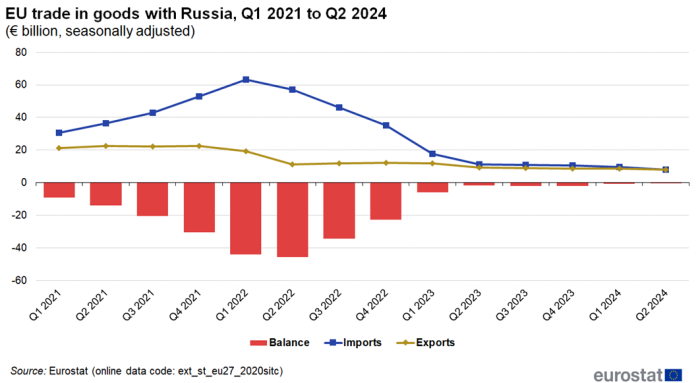
(€ billion, seasonally adjusted)
Source: Eurostat (ext_st_eu27_2020sitc)
When looking at the changes in Russia's shares in extra-EU trade, both exports and imports dropped considerably below the levels prior to Russia's invasion. Figure 2 shows that Russia's share in the extra-EU exports fell from 3.2% in the first quarter of 2022 to 1.2% in the second quarter of 2024. Over the same period, the share of extra-EU imports from Russia fell from 9.3% to 1.3%.

(% share in extra-EU trade, seasonally adjusted)
Source: Eurostat (ext_st_eu27_2020sitc)
When looking at quarterly data, the EU's total trade balance with Russia is strongly correlated with the balance for energy products. High prices for energy products in 2021 and 2022 caused a considerable trade deficit, peaking at €45.8 billion in the second quarter of 2022. However, import restrictions and falling energy prices significantly reduced the trade deficit, which stood at €0.2 billion in the second quarter of 2024.

(%)
Source: Eurostat (ext_st_eu27_2020sitc)
Key product groups imported by the EU from Russia
Figure 4 focuses on 5 product groups imported from Russia, selected because of their relevance with respect to total extra-EU imports in terms of share or in terms of their absolute value. These products accounted for more than 60% of all EU imports from Russia. There were import restrictions for natural gas, coal and petroleum oils with derogations. There were also restrictions for iron and steel and fertilisers, but not for all products in these product groups. These restrictions caused large drops in the imports of these products, although other factors could also have played a role. For imports of nickel there were no restrictions but here too, imports decreased considerably. Comparing the second quarter of 2022 with the second quarter of 2024 drops for nickel (-15 percentage points (pp)) and petroleum oil (-20 pp) were larger than for natural gas (-5 pp) and iron and steel (-4 pp). The share for fertilisers increased by 8 pp.
For each of these products, the development of value, volume and unit value for imports since the first quarter of 2021 are shown in the following section. In addition, the shares in imports by partner are shown for the second quarters of 2022, 2023 and 2024. This section uses non-seasonally adjusted data.
EU imports of nickel
In the second quarter of 2024, the volume of nickel imported from Russia was 58% of what it had been in the first quarter of 2021 (see Figure 5) while its value had dropped to 48% in the same period. Imports of nickel were not affected by a specific ban. Measured in value, EU imports of nickel from Russia increased strongly between the first quarter of 2021 and the first quarter of 2022 due to increasing demand and prices. In the following months they dropped considerably.
Russia's share in EU imports of nickel fell by 15 pp between the second quarters of 2022 and 2024 (see Figure 6). The shares of the United States (+7 pp), Norway (+5 pp) and the United Kingdom (+4 pp) increased in this period.

value, indexed at 100 in Q1 2021
Source: Eurostat (ds-045409)
EU imports of petroleum oil
In the first quarter of 2024, the volume of petroleum oil imported from Russia was 6% of what it had been in the first quarter of 2021 (see Figure 7) while its value had dropped to 8% in the same period. EU imports of petroleum oil (combined crude and non-crude) from Russia in trade value almost doubled between the first quarter of 2021 and the first quarter of 2022 due to increasing prices. Russia was the largest provider of petroleum oils to the EU in 2021. After Russia's invasion, a major diversion in the trade of petroleum oil took place. Evidence of this became visible in the second and especially in the third and fourth quarters of 2022 and continued in 2023 and 2024.
The share of petroleum oil imports from Russia dropped from 21% in the second quarter of 2022 to 1% in the second quarter of 2024 (see Figure 8). The shares of the United States, Kazakhstan (both +4 pp), Norway and Saudi Arabia (both +3 pp) increased in this period.

value, indexed at 100 in Q1 2021
Source: Eurostat (ds-045409)
EU imports of fertilisers
In the first quarter of 2024 compared with the first quarter of 2021, the value index for imports of fertilisers from Russia decreased by 31 pp while the volume index had fallen 52 pp (see Figure 9). The value of the EU's imports of fertilisers from Russia more than doubled between the first quarters of 2021 and 2022, mostly as a result of rising prices.
Russia's share in extra-EU imports of fertilisers rose from 18% in the second quarter of 2022 to 21% in the second quarter of 2024. Egypt (17%) and Morocco (14%) were the next largest origins of fertiliser imports in the second quarter of 2024 (see Figure 10).

value, indexed at 100 in Q1 2021
Source: Eurostat (ds-045409)
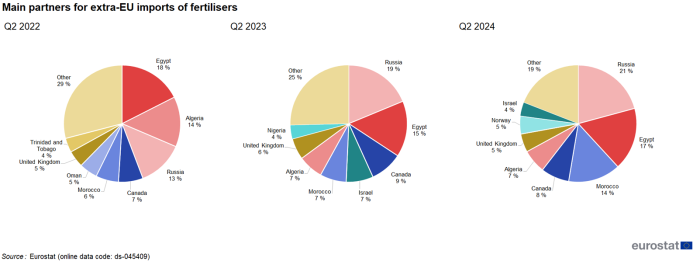
(%)
Source: Eurostat (ds-045409)
EU imports of iron and steel In the second quarter of 2024, both the value and volume of iron and steel imported from Russia was around a half of what it had been in the first quarter of 2021 (see Figure 11). The value of the EU's imports of iron and steel from Russia increased by 63 pp between the first quarters of 2021 and 2022 mainly due to rising prices. Subsequently, drops in volume and value were observed because of the sanctions on several products.
Russia's share in extra-EU imports of iron and steel dropped by 4 pp) in the second quarter of 2024 compared with the second quarter of 2022 when it was still the largest import partner (see Figure 12). India became the largest origin for EU imports of iron and steel with a share of 12%, while South Korea, the United Kingdom and Turkey also had higher shares than Russia in the second quarter of 2024.

value, indexed at 100 in Q1 2021
Source: Eurostat (ds-045409)
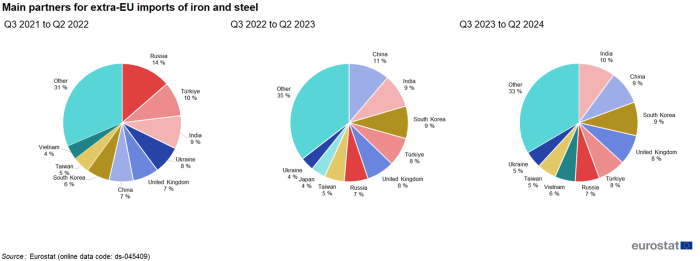
(%)
Source: Eurostat (ds-045409)
EU imports of liquefied natural gas
In the first quarter of 2024, the volume of liquefied natural gas imported from Russia were 7% higher than in the first quarter of 2021 (see Figure 13). However, due to rising prices its value in this period increased by 164%. The value of EU imports of liquefied natural gas from Russia increased considerably between the first quarter of 2021 and the third quarter of 2022 as prices increased sharply. Measured in value, imports of natural gas from Russia steadily decreased until the third quarter of 2023, increased in the next two quarters before falling in the second quarter of 2024..
Russia's share in EU imports of liquefied natural gas dropped from 16% in the second quarter of 2022 to 13% in the second quarter of 2023 but bounced back to 18% in the second quarter of 2024 (see Figure 14). The highest share in the second quarter of 2024 was observed for the United States (46%).

value, indexed at 100 in Q1 2021
Source: Eurostat (ds-045409)

(%)
Source: Eurostat (ds-045409)
EU imports of natural gas in gaseous state
In the second quarter of 2024, the volume of natural gas in gaseous state imported from Russia were 59% lower than in the first quarter of 2021 (see Figure 15). However, due to rising prices its value in this period decreased by only 32%. The value of EU imports of natural gas in gaseous state from Russia increased considerably between the first quarter of 2021 and the third quarter of 2022 as prices increased sharply. In the following quarters both volume and value decreased considerably.
Russia's share in EU imports of natural gas in gaseous state dropped from 29% in the second quarter of 2022 to 18% in the second quarter of 2024 (see Figure 16). In this period the share for Algeria (+21%) increased most.

value, indexed at 100 in Q1 2021
Source: Eurostat (ds-045409)
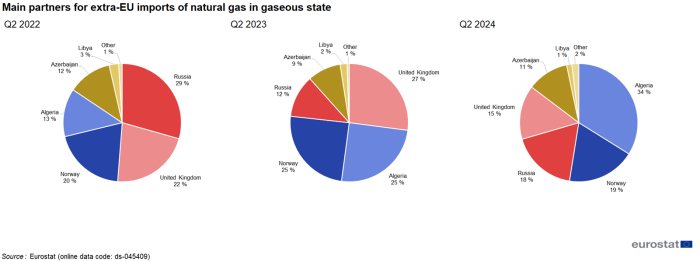
(%)
Source: Eurostat (ds-045409)
Main product groups in EU exports to Russia
The EU also exported a wide range of products to Russia. In value terms, the largest product groups exported to Russia in the first quarter of 2021 were machinery, vehicles, pharmaceuticals, electrical machinery and plastics. The weight of these exports is shown in Table 2. Between the first quarter of 2021 and the second quarter of 2024 exports for 4 of these 5 product groups had dropped considerably, the exception being pharmaceuticals which stood at €2 032 million in the second quarter of 2024, after having peaked at €2 894 million in the fourth quarter of 2022.

(€ million, quarterly data)
Source: Eurostat (ds-045409)

(1 000 tonnes, quarterly data)
Source: Eurostat (ds-045409)
Source data for tables and graphs
Data sources
EU data is taken from Eurostat's COMEXT database. COMEXT is the reference database for international trade in goods. It provides access not only to both recent and historical data from the EU Member States but also to statistics of a significant number of non-EU countries. International trade aggregated and detailed statistics disseminated via the Eurostat website are compiled from COMEXT data according to a monthly process.
Data are collected by the competent national authorities of the EU Member States and compiled according to a harmonised methodology established by EU regulations before transmission to Eurostat. For extra-EU trade, the statistical information is mainly provided by the traders on the basis of customs declarations.
EU data are compiled according to EU guidelines and may, therefore, differ from national data published by the Member States. Statistics on extra-EU trade are calculated as the sum of trade of each of the 27 EU Member States with countries outside the EU. In other words, the EU is considered as a single trading entity and trade flows are measured into and out of the area, but not within it.
Methodology
According to EU concepts and definitions, extra-EU trade statistics (trade between EU Member States and non-EU countries) do not record exchanges involving goods in transit, placed in a customs warehouse or given temporary admission (for trade fairs, temporary exhibitions, tests, etc.). This is known as 'special trade'. The partner is the country of final destination of the goods for exports and the country of origin for imports.
Product classification
Information on commodities exported and imported is presented according to the Harmonised System for product classification. A full description is available from Eurostat's classification server [1].
Figure 3 is based on the SITC classification in which the main categories are:
- food, drinks and tobacco (Sections 0 and 1 - including live animals);
- raw materials (Sections 2 and 4);
- energy products (Section 3);
- chemicals and related products (Section 5 - including pharmaceuticals and plastics);
- machinery and transport equipment (Section 7);
- other manufactured goods (Sections 6 and 8);
- other goods (Section 9).
Unit of measure
Trade values are expressed in millions or billions (109) of euros. They correspond to the statistical value, i.e. to the amount which would be invoiced in case of sale or purchase at the national border of the reporting country. It is called an FOB value (free on board) for exports and a CIF value (cost, insurance, freight) for imports.
Context
Trade is an important indicator of Europe's prosperity and place in the world. The bloc is deeply integrated into global markets both for the products it sources and the exports it sells. The EU trade policy is one of the main pillars of the EU's relations with the rest of the world.
Because the 27 EU Member States share a single market and a single external border, they also have a single trade policy. EU Member States speak and negotiate collectively, both in the World Trade Organisation, where the rules of international trade are agreed and enforced and with individual trading partners. This common policy enables them to speak with one voice in trade negotiations, maximising their impact in such negotiations. This is even more important in a globalised world in which economies tend to cluster together in regional groups.
The openness of the EU's trade regime has meant that the EU is the largest player on the global trading scene and remains a good region to do business with. Thanks to the ease of modern transport and communications, it is now easier to produce, buy and sell goods around the world which gives European companies of every size the potential to trade outside Europe.
Direct access to


